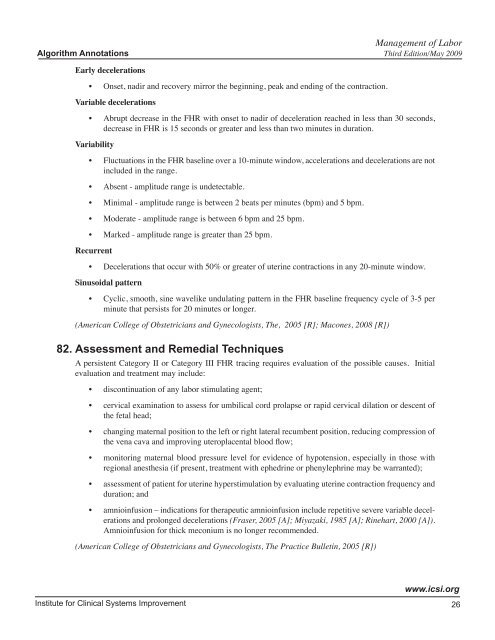Management of Labor
Management of Labor
Management of Labor
You also want an ePaper? Increase the reach of your titles
YUMPU automatically turns print PDFs into web optimized ePapers that Google loves.
<strong>Management</strong> <strong>of</strong> <strong>Labor</strong><br />
Algorithm Annotations Third Edition/May 2009<br />
Early decelerations<br />
• Onset, nadir and recovery mirror the beginning, peak and ending <strong>of</strong> the contraction.<br />
Variable decelerations<br />
• Abrupt decrease in the FHR with onset to nadir <strong>of</strong> deceleration reached in less than 30 seconds,<br />
decrease in FHR is 15 seconds or greater and less than two minutes in duration.<br />
Variability<br />
• Fluctuations in the FHR baseline over a 10-minute window, accelerations and decelerations are not<br />
included in the range.<br />
• Absent - amplitude range is undetectable.<br />
• Minimal - amplitude range is between 2 beats per minutes (bpm) and 5 bpm.<br />
• Moderate - amplitude range is between 6 bpm and 25 bpm.<br />
• Marked - amplitude range is greater than 25 bpm.<br />
Recurrent<br />
• Decelerations that occur with 50% or greater <strong>of</strong> uterine contractions in any 20-minute window.<br />
Sinusoidal pattern<br />
• Cyclic, smooth, sine wavelike undulating pattern in the FHR baseline frequency cycle <strong>of</strong> 3-5 per<br />
minute that persists for 20 minutes or longer.<br />
(American College <strong>of</strong> Obstetricians and Gynecologists, The, 2005 [R]; Macones, 2008 [R])<br />
82. Assessment and Remedial Techniques<br />
A persistent Category II or Category III FHR tracing requires evaluation <strong>of</strong> the possible causes. Initial<br />
evaluation and treatment may include:<br />
• discontinuation <strong>of</strong> any labor stimulating agent;<br />
• cervical examination to assess for umbilical cord prolapse or rapid cervical dilation or descent <strong>of</strong><br />
the fetal head;<br />
• changing maternal position to the left or right lateral recumbent position, reducing compression <strong>of</strong><br />
the vena cava and improving uteroplacental blood flow;<br />
• monitoring maternal blood pressure level for evidence <strong>of</strong> hypotension, especially in those with<br />
regional anesthesia (if present, treatment with ephedrine or phenylephrine may be warranted);<br />
• assessment <strong>of</strong> patient for uterine hyperstimulation by evaluating uterine contraction frequency and<br />
duration; and<br />
• amnioinfusion – indications for therapeutic amnioinfusion include repetitive severe variable decelerations<br />
and prolonged decelerations (Fraser, 2005 [A]; Miyazaki, 1985 [A]; Rinehart, 2000 [A]).<br />
Amnioinfusion for thick meconium is no longer recommended.<br />
(American College <strong>of</strong> Obstetricians and Gynecologists, The Practice Bulletin, 2005 [R])<br />
Institute for Clinical Systems Improvement<br />
www.icsi.org<br />
26
















